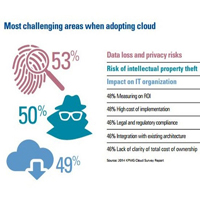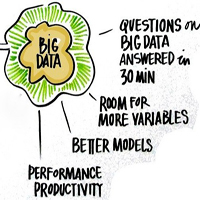In This Issue
- Cybersecurity at Top
- Big Data Market Grows
- Crowd Computing
- Report from the CEO
- VZ Managed Security
- Soft-ex/Telefonica UK
- Microsoft & Rackspace
- IoT: Mass Surveillance
- More Hacker Attacks
- Cybersecurity Tsk Frc
- CrowdStrike $100 Mil
- Data Security Strategy
- Big Data Open Source
- Predictive Analytics
- Prepping for Big Data
- Customer Experience
- Coming DCIA Events
Cybersecurity Leadership Must Start at the Top
Excerpted from Forbes Post by John Chambers and John Stewart
 If the past year has shown us anything, it’s that companies should no longer ask if they are going to be hacked and instead when.
If the past year has shown us anything, it’s that companies should no longer ask if they are going to be hacked and instead when.
With every company becoming digital, the pace of change is only accelerating and our ability to make the right decisions on cybersecurity needs to move even faster.
Some estimate that between $9 and $21 trillion of global economic value creation could be at risk if companies and governments are unable to successfully combat cyber-threats.
As cities, countries, and companies navigate at the fast pace of change in this new era of the Internet, security will become more essential to the business and in many cases, will help drive growth.
Businesses will be driven by security embedded in the network, architecture, data at the edge, and convergence of applications.
Transformations such as the one we are experiencing now will also require smart leadership from the board and the c-suite… Read More
Big Data Market to Grow Rapidly Through 2019
Excerpted from eWeek Report by Nathan Eddy
 The big data software market will grow nearly six-fold by 2019, according to IT research firm Ovum’s latest market size and forecast report on information management software.
The big data software market will grow nearly six-fold by 2019, according to IT research firm Ovum’s latest market size and forecast report on information management software.
The report highlights the fact that while big data software in 2015 is just a small part of the overall market for information management, it is set to increase at a compound annual growth rate (CAGR) of 50 percent through 2019 and play an increasingly important role that will position big data analytics as a core capability for many enterprises by 2019.
“Ovum is seeing big data move from experimental deployments to operationalized tools, driven by a number of use cases; particularly customer insights, risk and fraud, and security analytics,” Tom Pringle, Practice Leader of Information Management at Ovum, told eWEEK.
“Each of these cases speaks to the inherent challenges of big data, not just the volume of data to be stored and analyzed, but the speed with which that data is created and the variety of types.”
“We see and expect financial services, telecommunications, including Internet companies, and retail to be among the strongest early adopters of big data technology,” he added… Read More
Crowd Computing Cuts Research Time by 37,000 Years
Excerpted from Times of Israel Report by David Shamah
 It could have taken researchers at Tel Aviv University and Tsinghua University 37,000 years to figure out how carbon nanotubes help filter out impurities from flowing water.
It could have taken researchers at Tel Aviv University and Tsinghua University 37,000 years to figure out how carbon nanotubes help filter out impurities from flowing water.
But thanks to a crowdsourced computer platform, in which tens of thousands of computer users around the world contributed their processing power, the process was cut down to about a year.
“Crowdsourced computing is playing an increasingly major role in scientific breakthroughs,” said Professor Michael Urbakh, one of the chief researchers on the project.
“As our research shows, the range of questions that can benefit from public participation is growing all the time.”
The program, which ran through late 2013 through August 2014, was a joint effort of researchers at Tsinghua University at Tel Aviv University, at the TAU-Tsinghua XIN Center, a joint research institute established by the universities in 2010.
The study was led by Professor Quanshui Zheng of the Tsinghua Center for Nano and Micro Mechanics and Professor Urbakh of the TAU School of Chemistry at the Raymond & Beverly Sackler Faculty of Exact Sciences… Read More
Report from DCIA CEO Marty Lafferty
 Last week’s report centering on cybersecurity noted that we’re experiencing more and more demand for data scientists as well as cybersecurity experts in government and industry.
Last week’s report centering on cybersecurity noted that we’re experiencing more and more demand for data scientists as well as cybersecurity experts in government and industry.
One of the drivers for this is the exponential growth in the generation of digital information by enterprises and agencies.
But as larger networks and more input terminals — including mobile devices — generate more data to analyze, they also create increased risk.
Encrypting data is essential, but even more important is controlling and monitoring access to sensitive information.
When cyber-criminals gain access using legitimate credentials, it is data analytics that will provide protection by building profiles to identify user activities that deviate from normal behavior.
All data should be considered security relevant — and adopting this mindset will help establish a proactive cybersecurity posture.
Gartner recently reported that more than half of business leaders have difficulty finding qualified talent to analyze and interpret raw data and transform it into actionable insights.
Walmart recently applied crowdsourcing through Kaggle, enlisting consumers to analyze special events and sales results and then extrapolate future outcomes.
As a result, Walmart hired several people for its analytics team, including some who wouldn’t have been considered based on their resumes alone.
For those organizations that have sufficient resources, the next steps are to democratize decisions based on expertly analyzed data and get business intelligence to users more quickly.
Challenges range from data-siloing within departments — rather than sharing it across departments — to using incompatible solutions to analyze disparate data sets even within single departments.
Eliminating complexities, decreasing costs, and providing organizations with a more holistic view of their data are key areas for improvement.
Advancement will also be tied to smarter systems and less human involvement — as was the case with search engines, which moved away from having people categorize search results in order to scale.
Beyondcore recently applied its automated solution for Sears and found customer insights in ten minutes that the company had failed to discover in five months of analyzing the same data.
One thing is clear: we’re still in the early days of Big Data. Share wisely, and take care.
Verizon Launches Managed Security Service
Excerpted from ZDNet Report by Larry Dignan
 Verizon on Thursday launched a turnkey managed security service that it hopes will appeal to enterprises of all sizes.
Verizon on Thursday launched a turnkey managed security service that it hopes will appeal to enterprises of all sizes.
The telecom giant’s enterprise unit outlined Unified Security Services (USS). The services will come in three tiers and are designed to be an IT security team in a box.
Verizon will use its networking expertise to protect networks and the data flowing into an enterprise.
At launch, Vincent Lee, Director of Product at Verizon Enterprise Solutions, explained that USS will be an on-premise appliance that will include things like firewall protection, VPN, anti-virus, and anti-spam as well as Wi-Fi segmentation.
Higher levels will offer security for Layer 7 network access controls and advanced encryption.
In the Fall, USS will be a cloud service. The US is the first market with Europe, Asia-Pacific, Latin America, and Canada coming in 2016.
“Our first target market is the Verizon customer, but we can deploy this service on anyone’s circuit,” said Lee.
For the on-premise deployment, Verizon will drop-ship an appliance with its partner Fortinet… Read More
Soft-ex to Provision Telefonica UK for Cloud Digital Services
Excerpted from Sys-Con Media Report
 WidePoint Corporation a leading provider of managed mobility services (MMS) specializing in cybersecurity and telecommunications lifecycle management (TLM) solutions, announced today that its subsidiary Soft-ex Communications has been selected by Telefonica UK to deliver cloud digital services to its major customers across all business segments.
WidePoint Corporation a leading provider of managed mobility services (MMS) specializing in cybersecurity and telecommunications lifecycle management (TLM) solutions, announced today that its subsidiary Soft-ex Communications has been selected by Telefonica UK to deliver cloud digital services to its major customers across all business segments.
The initial three-year services arrangement has the potential to yield a multi-million pound sterling revenue opportunity to Soft-ex.
Under this agreement, Soft-ex will provide its online bill presentment and analytics solution to Telefonica UK clients.
These large enterprise and public sector customers will now be able to view their consolidated bills for mobile, fixed, and PBX in a single location.
With access to a centralized cloud portal, customers will be able to reduce time spent searching and analyzing their telecom expenses, leaving them more time to focus on reducing overall costs, improving inventory control, and introducing business efficiencies.
Ian Sparling, Chief Executive Officer at Soft-ex, commented, “Customers want to be reassured they are getting the best deal… Read More
Microsoft and Rackspace Form Cloud Alliance
Excerpted from Wall St. Journal by Shira Ovide
 Microsoft and data center services company Rackspace are teaming up to ease customers over barriers to using Azure, Microsoft’s cloud computing service.
Microsoft and data center services company Rackspace are teaming up to ease customers over barriers to using Azure, Microsoft’s cloud computing service.
Under an alliance set to be announced Monday, Rackspace will help companies start using Azure and guide them on how to squeeze the most for their money from Azure’s processing, data storage, databases and other services. Rackspace will help solve service or security problems and help companies combine Azure with their own computing facilities.
The pact is aimed, in part, at addressing the tangle of technology headaches many businesses encounter as they shift from on-premises computing to cloud services. Analysts say such issues are among the biggest barriers holding back companies from using shared processing and storage over the Internet.
Rackspace is known for top-tier technology support and customer service. Its reputation could give Microsoft a leg up as the software giant tries to catch up to market leader Amazon’s Amazon Web Services (AWS).
“This is a way for them to enlarge the market for Azure customers,” said Rackspace CEO Taylor Rhodes.
The deal adds to strategic alliances forged by Microsoft CEO Satya Nadella that make it easier for companies to use Microsoft services… Read More
IoT: Greatest Mass Surveillance Infrastructure Ever?
Excerpted from The Guardian Report by Julia Powles
 Does the expanding network of connected devices herald a brave new compact for our digital lives — or the end of politics?
Does the expanding network of connected devices herald a brave new compact for our digital lives — or the end of politics?
The word “thing,” in Old English, means a meeting or assembly. In the epic poem Beowulf, the eponymous hero declares he’ll “alone hold a thing” with the monster Grendel, who is terrorizing the Danes in the great hall of Heorot.
Beowulf uses “thing” euphemistically — it is a meeting that immediately descends into a fight. The Icelandic Parliament is still called Althing. But over the ages, “things” have gradually evolved from meetings to matter.
Today, we primarily use the term “thing” to refer to objects. Even in this sense, however, things are still core to our political and social lives.
An appreciation that things have always been about community and politics, whether literally, or through the creation and respect of systems of private property, provides a useful backdrop to the recent book, Pax Technica: How the Internet of Things May Set Us Free or Lock Us Up, by writer and professor of communication, Philip N Howard.
Howard’s thesis is that the much-hyped Internet of Things (IoT) – the expanding network of connected devices… Read More
Excerpted from NY Post Report by Beckie Strum
 Expect more news of hack attacks on US government computers, the federal Chief Information Officer (CIO) said in an interview published Saturday.
Expect more news of hack attacks on US government computers, the federal Chief Information Officer (CIO) said in an interview published Saturday.
The government is searching hard for incidents of data and ID theft and other breaches, said Tony Scott, appointed by President Obama in February as Chief of the Office of Electronic Government and Information Technology.
Scott launched a 30-day government-wide blitz on cybersecurity in the wake of a massive system breach in which hackers stole the private information, including Social Security numbers, of 21.5 million Americans.
“We said, ‘Run hard for the next 30 days and get big progress on these things. No excuses, just get it done,'” Scott told Reuters.
The blitz has just ended — and it gave Scott little doubt that more security breaches will be found.
“I think it’s a realistic chance, and I think this is true no matter where you go. It’s not unique to the federal government,” said Scott, who spent 35 years in the private sector running systems at companies such as Microsoft, Disney, and General Motors… Read More
Cybersecurity Task Force Looks to Next Administration
Excerpted from Federal Times Report by Aaron Boyd
 A group of former federal officials and industry experts are getting together to ensure major cybersecurity initiatives don’t fall through the cracks as more candidates pile into the 2016 race and Washington prepares for a transition in leadership.
A group of former federal officials and industry experts are getting together to ensure major cybersecurity initiatives don’t fall through the cracks as more candidates pile into the 2016 race and Washington prepares for a transition in leadership.
The Center for Strategic and International Studies has brought together a cybersecurity task force made up of experts from the public and private sector to issue a series of reports, culminating in a transition report with recommendations a new administration can put in place within the first 60 days.
“You don’t want to lose the momentum that this administration is creating with the things that they’re doing,” said Karen Evans, Director of the US Cyber Challenge and advisor to the task force.
“You don’t want a new administration to come in and have a hiatus where things aren’t happening.”
Evans stressed the importance of issuing actionable recommendations — such as suggestions for executive orders that include specific language — that the next administration can implement immediately, regardless of party affiliation.
“The report should be written in a way that it doesn’t matter who wins,” said James Lewis, CSIS Senior Fellow… Read More
Excerpted from NY Times Report by Michael de la Merced
 In the wake of computer attacks on the government and other prominent targets, investor interest in cybersecurity is unsurprisingly high.
In the wake of computer attacks on the government and other prominent targets, investor interest in cybersecurity is unsurprisingly high.
The latest indication of that enthusiasm: CrowdStrike, a security services provider focused on stopping attacks before they happen, announced on Monday that it had raised $100 million in a new round of financing.
The investment was led by Google Capital, one of the technology giant’s venture capital arms, in its first cybersecurity deal. It also included Rackspace, the web-hosting services company and a client of the nearly four-year-old start-up. Others in the round included existing investors Accel Partners and Warburg Pincus.
As reminders about innumerable holes in security defenses emerge — most recently when the federal Office of Personnel Management disclosed that two cyber-intrusions pilfered the personal information of more than 21 million people — cybersecurity has become a significant concern to companies, and a focus of private investors.
Nearly $2.4 billion was invested in the sector last year, almost double the amount in 2013, according to a report by the research firm CB Insights. CrowdStrike is positioning itself as a next-generation solution for security… Read More
Strategies for Data Security in Use of Cloud Services
Excerpted from The National Law Review Report by Barbara Melby and Matthew Liebenson
 Companies across virtually all industries use (or are considering using) cloud services to support their businesses. SiliconAngle reports that more than 60% of businesses use cloud computing, and the average organization uses 545 cloud services.
Companies across virtually all industries use (or are considering using) cloud services to support their businesses. SiliconAngle reports that more than 60% of businesses use cloud computing, and the average organization uses 545 cloud services.
Providers of cloud services offer powerful, scalable, and — in many cases — financially attractive solutions to meet various business needs, including technology needs (such as access to applications, storage, and computing power) as well as “business function” needs (such as payroll administration, recruitment assistance, and data analytics).
Some of the biggest impediments to placing data “in the cloud” are concerns regarding security and compliance with data privacy regulations.
These issues are heightened for organizations handling sensitive or personal, financial, or health data. As data breaches in the news raise awareness about data security issues, smart companies are exploring new strategies for securing their data when using cloud services.
A recent Information Age article provides some data security guidelines for companies using or considering cloud services… Read More
Big Data Problems Solved Fast on Open Source Platform
Excerpted from Forbes Report by Tom Groenfeldt
 “If you have a big problem like fraud you don’t want to wait three years until you can act on your insights,” said Ingo Mierswa, founder and CTO of RapidMiner, a predictive analytics firm that ranks in Gartner’s Magic Quadrant for Advanced Analytics Platforms.
“If you have a big problem like fraud you don’t want to wait three years until you can act on your insights,” said Ingo Mierswa, founder and CTO of RapidMiner, a predictive analytics firm that ranks in Gartner’s Magic Quadrant for Advanced Analytics Platforms.
The company, which grew out of research at the Artificial Intelligence Unit of the Technical University of Dortmund in Germany, became a company in 2006 and set up its headquarters in Boston in 2013. It received a $15 million B round of funding in February.
The platform is designed to be easy to use and understand for business decision makers who don’t necessarily have advanced degrees in mathematics or physics. With an open source heritage, RapidMiner has a community of 250,000 users and about 600 academics, said Mierswa, so users facing a problem can often learn how others did it.
“It’s like having a small data scientist sitting on your shoulder; you can tap a community of experts,” he said.
Time to implementation is one of the company’s bragging points.
“We had Hitachi, a consultancy working with a major bank in Japan, come for a week or 10 days of training in RapidMiner,” Mierswa recounted… Read More
Evaluating Big Data and Predictive Analytics
Excerpted from B2C Report by Mark Camilleri
 The use of business intelligence and marketing information systems has expanded in recent years. Through advancements in technologies, marketers can extract value from very large data sets.
The use of business intelligence and marketing information systems has expanded in recent years. Through advancements in technologies, marketers can extract value from very large data sets.
Very often, companies can benefit if they use and reuse the same data to extract added value from it. Sometimes, it would also make sense for these companies to acquire data that they do not own (or data that was not collected).
All individuals leave a “digital trail” of data as they move about in the virtual and physical worlds. This phenomenon is called, “data exhaust”.
Initially, this term was used to describe how Amazon used predictive analytics in order to suggest items for its customers.
Predictive analytics could quantify the likelihood that a particular person will do something — whether it is defaulting on a loan, upgrading to a higher level of cable service or seeking another job.
Such data anticipates human behaviors that have not happened as yet. For instance, Fedex has predicted which customers were most likely to defect to competitors. Even, Hewlett-Packard made a good use of suitable data… Read More
Prepping Big Data for High Performance
Excerpted from Database Review Journal Report by Lockwood Lyon
 Big data applications are common in large IT enterprises. The ability to analyze historical data and predict trends delivers value; in addition, business intelligence (BI) analytics can pay big dividends by avoiding outages and resource shortages, reducing service level agreements (SLAs) and forecasting customer demands for products and services.
Big data applications are common in large IT enterprises. The ability to analyze historical data and predict trends delivers value; in addition, business intelligence (BI) analytics can pay big dividends by avoiding outages and resource shortages, reducing service level agreements (SLAs) and forecasting customer demands for products and services.
As the holiday season approaches, your organization can expect more BI activity as you take advantage of a significant increase in customer interactions. The smart IT organization should be proactive and prepare now for larger data volumes and more analytics activity by tuning their big data application for high performance.
There are three primary areas where the database administrator (DBA) and IT support staff should concentrate their efforts: disaster recovery, data warehouse performance, and data organization and storage in the big data application.
Most IT support staff do not consider disaster recovery to be related to performance tuning. In a big data environment this belief is reinforced by the perception that business analytics queries against your big data application are not as important as operational systems such as payroll, general ledger, order entry, shipping, and customer service applications.
However, big data applications have matured in the past several years, and the enterprise’s use of business analytics has matured as well… Read More
Mastering Big Data to Drive Great Customer Experience
Excerpted from ComputerWorld Report by Prash Chandramohan
 I am a big fan of walking into a retail store versus buying things online. This is specifically true for clothes from my favorite retail chain since it gives me access to physically see a wide variety of options combined with great ambiance, music, and sales assistants who go the extra mile to help me make the right choice.
I am a big fan of walking into a retail store versus buying things online. This is specifically true for clothes from my favorite retail chain since it gives me access to physically see a wide variety of options combined with great ambiance, music, and sales assistants who go the extra mile to help me make the right choice.
I fear I end up buying more items than I planned, but the store-buying experience makes me feel valued as a customer. However, before I head to the store, I check out the store’s website to see what’s new, find different colors and styles, and sometimes add things I like to the online cart.
I am also a huge admirer of social media. I often use Twitter as a way to communicate with my retailer and check out their Facebook page to see what’s new. When I am in the shop, I check-in to the store using Swarm (Foursquare).
When you look from the retailer’s point of view, I am giving them several ways in which they can communicate with and understand me.
By connecting my interactions via these different channels with my location data and my preferences, the retailer has a great opportunity to give me a consistent and quality experience, leading to a win-win situation for both me and the retailer… Read More
Coming Events of Interest
ADRM Working Group Meeting — July 30th via Global Videoconference. Contact the DCIA for information about joining the group and attending the meeting that will focus on interoperability among DRM platforms and simplifying DRM implementation.
Cloud Computing Boot Camp — July 30th in Washington, DC. Designed for small-to-medium businesses (SMBs) and their counterparts in government agencies and healthcare organizations whose responsibilities include evaluating, purchasing, and implementing cloud-based solutions.
The Internet of Things (IoT) Show — September 2nd-23rd in Singapore. The IoT Show will facilitate new collaborations and partnerships as well as generate new ideas and thinking. The IoT Show is about getting the prototypes out of the lab and into the market.
Digital Hollywood Fall — October 19th-22nd in Marina Del Rey, CA. The future of the entertainment industry. Digital Hollywood debuted in 1990 and has from its start been among the leading trade conferences in its field.
2015 US Cyber Crime Conference — November 18th-20th in National Harbor, MD. This is the only event of its kind that provides both hands-on digital forensics training and an interactive forum for cyber professionals to network.
Internet of Things World Forum (IoTWF) — December 6th-8th in Dubai, . IoTWF is an exclusive event that brings together the best and brightest thinkers, practitioners, and innovators from business, government, and academia to accelerate the market adoption of the Internet of Things.
